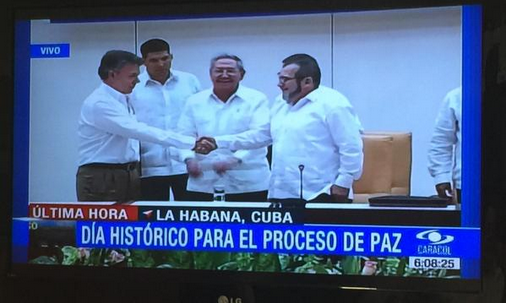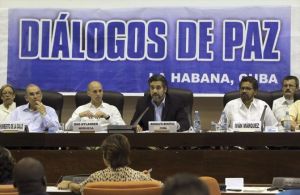© Olivier Vogel, 24 September 2015, Beirut.
In an unprecedented joint appearance, Colombia’s president Juan Manuel Santos and FARC supreme leader ‘Timoschenko’ met with their respective delegations in Havana, September 23, to present a “Special Jurisdiction for Peace”. The common statement on the first detailed modalities on transitional justice marks the most important breakthrough in the peace negotiations since they have begun in October 2012. It also sets a final date to formally end the longest-running armed conflict in the Western hemisphere with a peace agreement within the next six months.
Most importantly, the “Joint Declaration No. 60” establishes a transitional judicial mechanism including two organs: a “Chamber of Justice” and a “Tribunal for Peace”. Both entities will be integrated primarily by Colombian judges with a “minor participation of international judges that fulfil the highest prerequisites”. The primary functions of the Special Jurisdiction for Peace are to end impunity, obtain the truth, contribute to the reparation of the victims and judge and impose sanction for those responsible of serious crimes committed in the armed conflict. The emphasis will be put on the most serious and representative crimes as well as guarantees of non-repetition.
The Special Jurisdiction for Peace has the competence over all actors that participated in direct or indirect way in the armed conflict, including members of the FARC and agents of the state for crimes “committed in the context and because of the conflict”. The transitional justice scheme establishes differentiated treatment between those that recognize truth and responsibility and those that don’t or do it belatedly.
The Special Jurisdiction for Peace also grants a “most comprehensive amnesty for political and related crimes”. Although the related crimes have yet to be defined specifically in a domestic law, it is already clear that these will include the typical political crimes such as rebellion, sedition and riot. Amnesties could also include homicides or injuries caused to combatants and minor infractions of international humanitarian law committed during armed confrontations. The president of the Colombian Supreme Court stated that related crimes might also be crimes of drug trafficking. The law must determinate the exact scope.
For those considered the most responsible for serious international crimes (including war crimes, crimes against humanity and genocide) and recognize their responsibilities, the sanction will have a component of “restriction of liberties and rights”, guaranteeing reparative and restorative functions through the “realization of works and activities that satisfy the rights of the victims”. These sanctions will have a minimum of 5 years and a maximum of 8 years of “effective restriction of liberty, in special conditions”. Accused persons that recognize their responsibility belatedly will be sanctioned with ordinary incarceration (jail) between five and eight years. Those who don’t collaborate and result guilty may end behind bars up to 20 years in ordinary justice conditions. The alternative treatment is only accessible for those commiting themselves to re-socialization through (communitarian) “work, capacitation and studies” during the time they remain deprived of liberty.
In the case of FARC commanders and combatants, special and alternative judicial treatment is reserved under the condition of a gradual disarmament that has to start 60 days after the signing of a final peace agreement, ergo no later than 23 May 2016.
The Special Jurisdiction for Peace fulfils Colombia’s international obligations under international criminal law, international human rights law, international humanitarian law and its own domestic provisions. An effective punishment for those who committed the gravest international crimes further debilitates the arguments of the critics and enemies of the peace process, particularly the far-right opposition of Álvaro Uribe (Centro Democrático), Alejandro Ordóñez (Inspector General) and some parts of the Conservative Party or other right-wing elements in civil society.
The transitional justice preliminary agreement can also be expected to be considered in conformity with the Rome Statute by the Office of the Prosecutor of the ICC. Fatou Bensouda, ICC’s chief prosecutor, has always insisted on an effective sanction for those crimes the ICC has complementary jurisdiction for. The duration of sanctions (five to eight years) correspond with similar sanctions for paramilitaries during the controversial but valid Justice and Peace Law demobilization process in 2005. In several preliminary examination reports by the Office of the Prosecutor in the last years, these laws have been considered valid under international criminal law. It is therefore most likely that the Prosecutor in The Hague, along with the overwhelming majority of international state and non-state actors, will endorse this preliminary agreement.
The Special Jurisdiction for Peace accord clarifies some very crucial aspects of the future Colombian transitional justice scheme. Nevertheless, there are many important issues left that remain unspecified or omitted. First, the joint declaration does not specify the exact weighting and ratio of Colombian and international judges. Secondly, the selection progress and the appointment of the jurists for the mainly national ad-hoc entity are not clear yet. Thirdly, the declaration does not specify the controversial definition of “those most responsible” for international crimes. The selection criteria remain open. The jurisdiction will sanction “those responsible for grave crimes” and “particularly the gravest and representative crimes” but until now, it is not said if this formula may include middle-rank commanders or low-rank combatants that were indirectly involved in international crimes. Lastly, whilst the restriction of liberties is relatively specific, the term “restriction of rights” is not. In particular, the participation in politics and the modalities of transformation of an illegal armed group into a legal political party are still under discussion.
The joint declaration and historic handshake between Santos and ‘Timochenko’ mark a never-seen-before breakthrough on the road towards a peace agreement, to be signed during the next six months. The preliminary agreement on transitional justice and victims’ rights finally makes the peace process virtually irreversible. It can be considered a huge step for transitional justice and the rights for victims of international crimes and armed conflict, first and foremost for Colombia but also for the international community.







